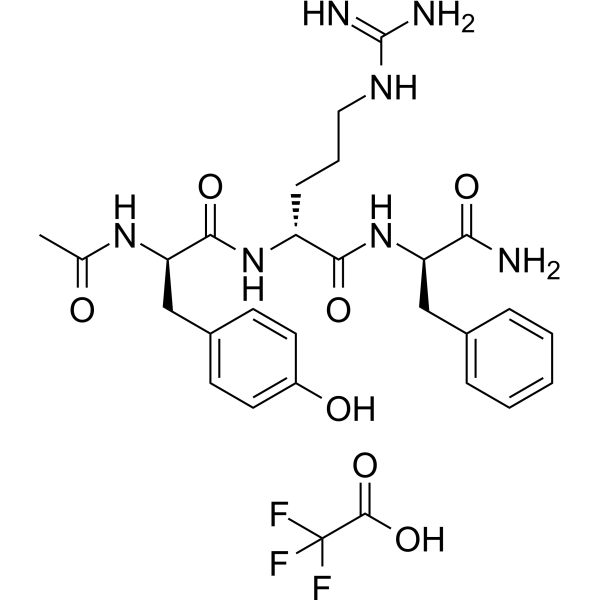Physicochemical Properties
| Molecular Formula | C28H36F3N7O7 |
| Molecular Weight | 639.623356819153 |
| Exact Mass | 639.26 |
| CAS # | 2759216-46-9 |
| Related CAS # | DTP3;1809784-29-9 |
| PubChem CID | 139600260 |
| Appearance | White to off-white solid powder |
| Hydrogen Bond Donor Count | 8 |
| Hydrogen Bond Acceptor Count | 11 |
| Rotatable Bond Count | 14 |
| Heavy Atom Count | 45 |
| Complexity | 902 |
| Defined Atom Stereocenter Count | 3 |
| SMILES | FC(C(=O)O)(F)F.O=C([C@@H](CCC/N=C(\N)/N)NC([C@@H](CC1C=CC(=CC=1)O)NC(C)=O)=O)N[C@@H](C(N)=O)CC1C=CC=CC=1 |
| InChi Key | JCVMRDQSOXBZIO-AFYLVLOISA-N |
| InChi Code | InChI=1S/C26H35N7O5.C2HF3O2/c1-16(34)31-22(15-18-9-11-19(35)12-10-18)25(38)32-20(8-5-13-30-26(28)29)24(37)33-21(23(27)36)14-17-6-3-2-4-7-17;3-2(4,5)1(6)7/h2-4,6-7,9-12,20-22,35H,5,8,13-15H2,1H3,(H2,27,36)(H,31,34)(H,32,38)(H,33,37)(H4,28,29,30);(H,6,7)/t20-,21-,22-;/m1./s1 |
| Chemical Name | (2R)-2-[[(2R)-2-acetamido-3-(4-hydroxyphenyl)propanoyl]amino]-N-[(2R)-1-amino-1-oxo-3-phenylpropan-2-yl]-5-(diaminomethylideneamino)pentanamide;2,2,2-trifluoroacetic acid |
| Synonyms | DTP3 TFA |
| HS Tariff Code | 2934.99.9001 |
| Storage |
Powder-20°C 3 years 4°C 2 years In solvent -80°C 6 months -20°C 1 month Note: Please store this product in a sealed and protected environment (e.g. under nitrogen), avoid exposure to moisture and light. |
| Shipping Condition | Room temperature (This product is stable at ambient temperature for a few days during ordinary shipping and time spent in Customs) |
Biological Activity
| Targets | GADD45β/MKK7 |
| ln Vitro | DTP3 (10 μM; 1-21 days) causes the development of phosphorylated JNK to appear as early as 24 hours after the strong and tumor-specific induction of JNK activation and apoptosis[2]. |
| ln Vivo | DTP3 TFA (sc; 14.5 mg/kg/day; 28 days) essentially eliminates established subcutaneous myeloma xenografts in mice and has demonstrated a remarkable tumor shrinkage[2]. The t1/2, CL, and Vd values of DTP3 TFA (intravenous injection; 10 mg/kg/day) are 1.26 hours, 27.13 ML/min/kg, and 2.80 L/kg, respectively[2]. |
| Cell Assay |
Western Blot Analysis[2] Cell Types: Multiple myeloma (MM) cell lines Tested Concentrations: 10 μM Incubation Duration: 1, 3, 5, 14, 21 days Experimental Results: Caused the appearance of phosphorylated JNK, as early as 24 hrs (hours). |
| Animal Protocol |
Animal/Disease Models: 6 to 8-week old male NOD/SCID (severe combined immunodeficient) mouse (NOD.CB17-Prkdcscid/IcrCrl; Charles River)[2] Doses: 14.5 mg/kg Route of Administration: Sc; daily; 28 days Experimental Results: Had shown a dramatic shrinkage of the tumors. Animal/Disease Models: CD1 male mice of 25-30 g[2] Doses: 10 mg/kg (pharmacokinetic/PK Study) Route of Administration: intravenous (iv)injection Experimental Results: Had t1/2 of 1.26 hrs (hours), CL of 27.13 ML/min/kg, and Vd of 2.80 L/kg. |
| References |
[1]. Preclinical toxicology and safety pharmacology of the first-in-class GADD45β/MKK7inhibitor and clinical candidate, DTP3. Toxicol Rep. 2019 Apr 19;6:369-379. [2]. Cancer-selective targeting of the NF-κB survival pathway with GADD45β/MKK7 inhibitors. Cancer Cell. 2014 Oct 13;26(4):495-508. |
Solubility Data
| Solubility (In Vitro) |
H2O : ~100 mg/mL (~156.3 mM) DMSO : ~50 mg/mL (~78.2 mM) |
| Solubility (In Vivo) |
Solubility in Formulation 1: ≥ 2.5 mg/mL (3.91 mM) (saturation unknown) in 10% DMSO + 40% PEG300 + 5% Tween80 + 45% Saline (add these co-solvents sequentially from left to right, and one by one), clear solution. For example, if 1 mL of working solution is to be prepared, you can add 100 μL of 25.0 mg/mL clear DMSO stock solution to 400 μL PEG300 and mix evenly; then add 50 μL Tween-80 to the above solution and mix evenly; then add 450 μL normal saline to adjust the volume to 1 mL. Preparation of saline: Dissolve 0.9 g of sodium chloride in 100 mL ddH₂ O to obtain a clear solution. Solubility in Formulation 2: ≥ 2.5 mg/mL (3.91 mM) (saturation unknown) in 10% DMSO + 90% (20% SBE-β-CD in Saline) (add these co-solvents sequentially from left to right, and one by one), clear solution. For example, if 1 mL of working solution is to be prepared, you can add 100 μL of 25.0 mg/mL clear DMSO stock solution to 900 μL of 20% SBE-β-CD physiological saline solution and mix evenly. Preparation of 20% SBE-β-CD in Saline (4°C,1 week): Dissolve 2 g SBE-β-CD in 10 mL saline to obtain a clear solution. Solubility in Formulation 3: ≥ 2.5 mg/mL (3.91 mM) (saturation unknown) in 10% DMSO + 90% Corn Oil (add these co-solvents sequentially from left to right, and one by one), clear solution. For example, if 1 mL of working solution is to be prepared, you can add 100 μL of 25.0 mg/mL clear DMSO stock solution to 900 μL of corn oil and mix evenly. Solubility in Formulation 4: 100 mg/mL (156.34 mM) in PBS (add these co-solvents sequentially from left to right, and one by one), clear solution; with ultrasonication. (Please use freshly prepared in vivo formulations for optimal results.) |
| Preparing Stock Solutions | 1 mg | 5 mg | 10 mg | |
| 1 mM | 1.5634 mL | 7.8171 mL | 15.6343 mL | |
| 5 mM | 0.3127 mL | 1.5634 mL | 3.1269 mL | |
| 10 mM | 0.1563 mL | 0.7817 mL | 1.5634 mL |
